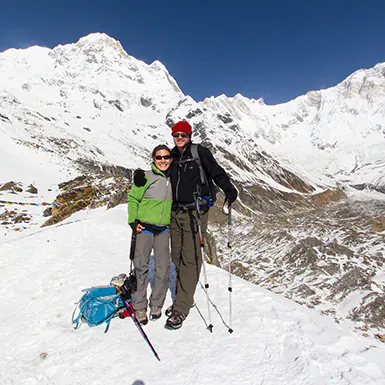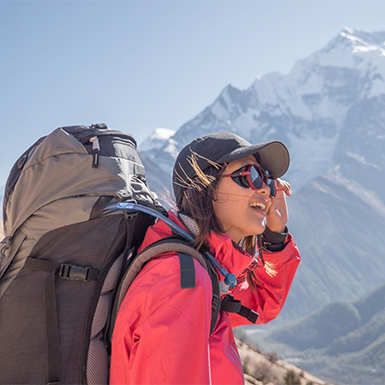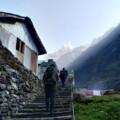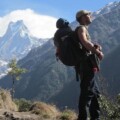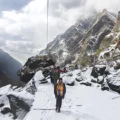The Annapurna Base Camp Trek is renowned as one of Nepal’s most iconic trekking adventures. It is a perfect destination to explore its cultural and geographical aspects. The trekking route involves varied ecological zones, such as thick woods, sleepy settlements, and high mountains, including Annapurna. At about 110 kilometers (68 miles), the Annapurna Base Camp Trek Distance is worth it because it takes you to the core of the Annapurna Sanctuary.
What makes this trek particularly popular among trekkers is the unique experience it offers. Here are some reasons why:
- Scenic Diversity: The trek covers a variety of terrains, from terraced fields and rhododendron forests to alpine meadows and glaciers, offering ever-changing vistas.
- Cultural Richness: As you progress through the trek, you pass through traditional Gurung and Magar villages, where you can witness and experience local customs and hospitality.
- Accessible Yet Challenging: The Annapurna Base Camp Trek is accessible to most people with a moderate fitness level, yet its elevation gain and varied terrain still present a satisfying challenge.
- Close-Up Mountain Views: The trek provides stunning close-up views of some of the highest peaks in the world, including Annapurna I, Machapuchare (Fishtail), and Hiunchuli.
- Natural Hot Springs: After trekking, relax in the natural hot springs at Jhinu Danda, a popular stop at the base camp.
- Well-Marked Trails: The well-maintained and marked trails ensure a safe and enjoyable trekking experience, even for those new to trekking in Nepal.
- Varied Itineraries: The trek offers flexible itineraries, allowing trekkers to choose routes that best suit their time and interests, including the popular ABC trek route that passes through Poon Hill.

Total Distance of the Annapurna Base Camp Trek
The total trek distance is crucial when planning your trek to the iconic Annapurna Base Camp. The path, spanning about 115 kilometers (71 miles) round trip, traverses diverse terrains that offer challenges and delights with gentle inclines, sharp ascents, and picturesque descents. Familiarizing yourself with the trek’s daily distance breakdown ensures effective planning and optimal preparation for this thrilling adventure.
Detailed Daily Distance Breakdown on the ABC Trek Route
Day 1: Pokhara to Nayapul to Tikhedhunga
- Distance: 17 km (10.5 miles)
- You’ll start with a drive from Pokhara to Nayapul and then trek 17 km to Tikhedhunga. This initial segment is relatively easy and ideal for accommodating the trek’s demands.
Day 2: Tikhedhunga to Ghorepani
- Distance: 13 km (8 miles)
- The trek to Ghorepani includes a sharp climb, especially during the ascent to Ulleri. Vibrant rhododendron forests line the path, offering a kaleidoscope of colors.
Day 3: Ghorepani to Poon Hill to Tadapani
- Distance: 15 km (9.3 miles)
- Starting before dawn, you’ll hike to Poon Hill to witness a stunning sunrise over the Annapurna and Dhaulagiri ranges. Then, you’ll head towards Tadapani, trekking through verdant forests with spectacular views.
Day 4: Tadapani to Chhomrong
- Distance: 10 km (6.2 miles)
- The path initially descends through thick forests before climbing to Chhomrong, a large Gurung village with intimate views of Annapurna South and Machapuchare.
Day 5: Chhomrong to Bamboo
- Distance: 7 km (4.3 miles)
- Descending to the Chhomrong Khola, you’ll ascend to Sinuwa and continue to Bamboo. This section features dense bamboo forests, enhancing the trek’s tranquility.
Day 6: Bamboo to Deurali
- Distance: 8 km (5 miles)
- The trail from Bamboo to Deurali grows steeper and more secluded, winding through the narrow Modi Khola valley, offering an adventurous and solitary experience.
Day 7: Deurali to Annapurna Base Camp via Machapuchare Base Camp
- Distance: 12 km (7.5 miles)
- Reaching Annapurna Base Camp is a trek highlight. You’ll pass through Machapuchare Base Camp, where the trail showcases breathtaking alpine landscapes and panoramic mountain vistas.
Days 8-10: Return Route
- Distance: Varies (typically quicker due to descent)
- Many trekkers retrace their steps to Chhomrong and veer towards Jhinu Danda to soak in the natural hot springs. They conclude their trek at Nayapul, followed by a drive back to Pokhara.
Additional Tips for the Annapurna Base Camp Trek
- Altitude Awareness: At Annapurna Base Camp, which sits at 4,130 meters (13,550 feet), you must pace yourself and allow sufficient time for acclimatization.
- Physical Preparation: Given the daily distances, regular exercise and specific trekking training are crucial to ensuring a smooth and enjoyable trek.
- Packing Essentials: Equip yourself with suitable gear for varying climatic conditions. Essential items include layers, a reliable trekking pole, and sturdy hiking boots.
Understanding the Trek Duration for Annapurna Base Camp
As you plan your hike, it’s essential to consider the Annapurna Base Camp Trek Distance and the time it will take to complete. The trekking time can differ depending on a hiker’s varying levels of fitness, previous expeditions, and walking speed.
Standard Trek Duration
The classic ABC trek route generally takes between 10 to 12 days for most trekkers. This schedule allows for a moderate pace, which is comfortable for people with average fitness levels without prior high-altitude trekking experience.
Factors Influencing Trek Duration
1. Fitness Level
- High Fitness: Individuals with high fitness levels may complete the trek in as few as 7 to 9 days. They often spend less time acclimatizing and can cover longer distances each day.
- Average Fitness: Most trekkers, particularly those who exercise regularly but aren’t used to high-altitude hiking, will find 10 to 12 days more manageable. This pace allows for gradual acclimatization and enjoying the scenery.
- Lower Fitness: 12 to 14 days may be necessary for those less accustomed to physical activity. This slower pace helps manage the trek’s physical demands more comfortably and reduces the risk of altitude sickness.
2. Acclimatization Needs
Adequate acclimatization is crucial, especially to safely enjoy the high points of the trek, like Annapurna Base Camp at 4,130 meters (13,550 feet). Including extra days in your itinerary for acclimatization can extend the trek duration but is vital for a safe and enjoyable experience.
3. Rest Days and Exploration
Some trekkers include rest days in villages like Ghorepani or Chhomrong. These days, short excursions, cultural interactions, rest, and recovery are possible. This approach extends the overall duration but enriches your trekking experience.
4. Recommended Itinerary Adjustments
- Include Buffer Days: It’s advisable to include one or two buffer days in your itinerary. These can be used either for rest or in case of delays due to weather or health issues.
- Seasonal Considerations: Trek durations might also vary with the seasons. During the monsoon or winter, conditions might necessitate a slower pace or extra days.

Route Details for the Annapurna Base Camp Trek
Navigating the Annapurna Base Camp Trek Distance offers several routes, each with unique characteristics and scenic offerings. Whether you opt for the classic trek via Poon Hill or choose a more direct approach, each route provides a distinct experience of the majestic Himalayas.
Main Routes to Annapurna Base Camp
Via Poon Hill
- Distance: This route extends the standard trek by a couple of days, making the total distance approximately 120 kilometers.
- Scenery and Attractions: The Poon Hill trek is famous for offering breathtaking sunrise views over the Annapurna and Dhaulagiri ranges. This detour allows trekkers to enjoy panoramic views from Poon Hill, considered one of the best viewpoints in the Annapurna region. The trail also winds through rhododendron forests, which bloom spectacularly in the spring, adding a vibrant burst of color to the trek.
Direct Route
- Distance: The more direct route to Annapurna Base Camp is shorter, covering around 115 kilometers, which allows trekkers to complete the trek in a slightly condensed timeframe.
- Scenery and Attractions: While this route skips the detour to Poon Hill, it still offers abundant natural beauty. Trekkers pass through various landscapes, from lush forests to rugged high-altitude terrain. The direct path also provides ample opportunities to interact with local communities and experience the rural lifestyle of the Nepalese countryside.
Comparing the Routes
Poon Hill Route:
- Advantages: It offers extended views of the Himalayas, additional acclimatization days, and a chance to experience the cultural richness of Ghorepani and other villages.
- Considerations: Requires more days, which might not suit everyone’s schedule.
Direct Route:
- Advantages: It is more concise and suitable for trekkers with limited time.
- Considerations: It provides less acclimatization and fewer opportunities for extended photography sessions and leisurely exploration.
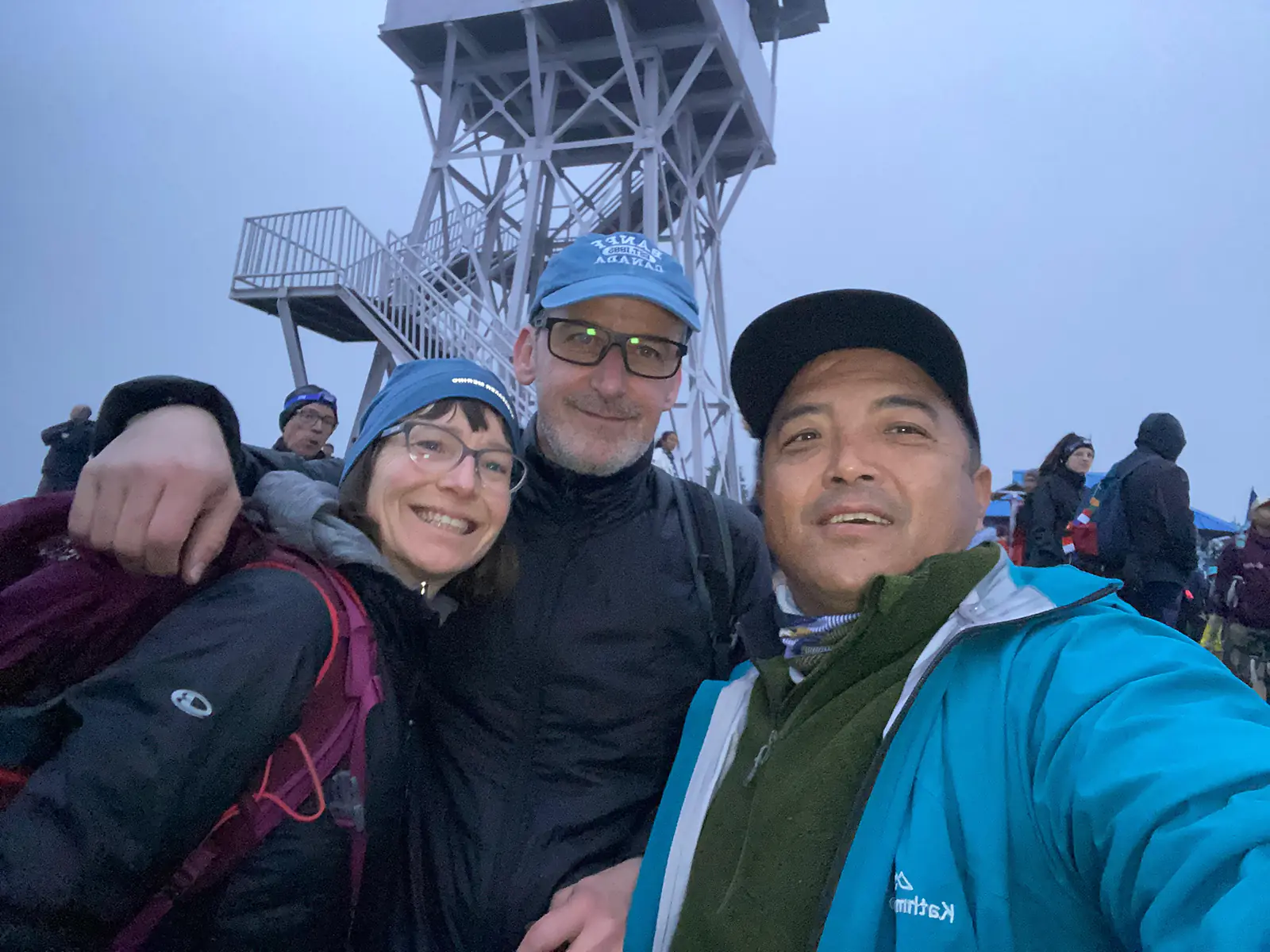
Altitude Insights for the Annapurna Base Camp Trek
Planning your trek along the Annapurna Base Camp Trek Distance demands a clear understanding of altitude variations, which present thrilling and challenging elements. Here’s essential altitude information and its impact on your trekking adventure.
Initial and Peak Altitudes
- Initial Altitude: The trek usually begins in Nayapul, about 1,070 meters (3,510 feet) above sea level.
- Peak Altitude at Annapurna Base Camp: The trek culminates at Annapurna Base Camp, which is approximately 4,130 meters (13,550 feet) high.
Elevation Gain Overview
From Nayapul to Annapurna Base Camp, you’ll experience a total elevation gain of about 3,060 meters (10,040 feet). As you near the base camp, this ascent unfolds over several trekking days, with the most substantial increases.
Challenges Due to Elevation Gain
Acute Mountain Sickness (AMS):
Ascending through different altitude zones heightens the risk of AMS. Early symptoms include headaches, nausea, dizziness, and fatigue. It is crucial to identify these symptoms early and either resting or descending to manage them effectively.
Increased Physical Effort:
Your body exerts more effort at higher elevations due to decreased oxygen levels. Even seasoned trekkers will notice a reduced pace as the altitude climbs.
Fluctuating Weather Conditions:
Elevated terrains often introduce colder temperatures and unpredictable weather patterns, including the possibility of quick snowfall or storms. Appropriate gear and clothing are essential to navigate these changes safely.
Strategies for Managing Altitude Challenges
- Plan for Acclimatization Days: It’s wise to schedule acclimatization stops within your trek, particularly at strategic villages like Ghorepani and Chhomrong. These stops help your body adapt to higher altitudes effectively.
- Stay Hydrated: Boosting your water intake is vital to counteract the effects of higher altitudes. Dehydration is common and can intensify altitude sickness if not addressed.
- Regulate Your Pace: Keeping a steady and sustainable pace throughout your trek helps prevent exhaustion and minimizes the risk of altitude sickness.
Estimating Daily Trekking Hours on the Annapurna Base Camp Trek
This method helps you effectively manage your energy and establish realistic expectations when planning your trek across the Annapurna Base Camp Trek Distance. The duration of daily treks can vary significantly depending on your pace and specific ABC trek route.
Typical Daily Trekking Hours
On average, trekkers walk 5 to 7 hours daily, including short breaks for lunch and rest. The total walking time varies depending on the terrain and altitude of each segment.
Variations Based on Pace
Fast-Paced Trekkers:
- Average Daily Hours: Fast-paced trekkers spend about 4 to 5 hours trekking each day. This quicker pace requires good physical condition and previous high-altitude trekking experience.
- Day-to-day Experience: Expect to start early and maintain a steady pace, with fewer and shorter breaks. Those looking to cover more ground or complete the trek in a shorter timeframe often choose this approach.
Slow-Paced Trekkers:
- Average Daily Hours: Those who prefer a leisurely pace might trek about 6 to 8 hours daily. This slower approach suits trekkers who take regular breaks and enjoy soaking in the scenery.
- Day-to-Day Experience: Starting the day at a comfortable time, taking ample breaks for photos, rest, and interaction with locals or other trekkers. This pace is ideal for those who prioritize the trek over the destination.
Managing Energy and Enjoyment
Regardless of your trekking pace, managing your energy throughout the day is crucial. Here are a few tips to enhance your trekking experience:
- Start Early: Begin your trek early in the morning to take advantage of cooler temperatures and quieter trails.
- Hydrate Regularly: Keeping hydrated is crucial, especially at higher altitudes where dehydration can sneak up on you.
- Plan Adequate Breaks: Whether you’re a fast or slow trekker, plan your breaks according to your body’s needs. It will help you maintain energy and enjoy and absorb the breathtaking views.

Physical Challenges and Difficulty Level
The Annapurna Base Camp Trek demands physical endurance due to its considerable distance and significant altitude changes. Here’s what you can expect:
- Distance: The trek spans approximately 115 kilometers on a round trip, requiring good physical conditioning. Trekkers typically walk 5 to 7 hours daily, which can test your endurance.
- Altitude Variations: The trek begins in Nayapul at about 1,070 meters and climbs to 4,130 meters at the base camp. This elevation gain can lead to challenges such as reduced oxygen levels and the risk of altitude sickness.
- Steep Sections: Some parts of the trek, especially near the base camp, are steep and physically demanding, adding to the overall exertion.
- Overall Difficulty: Given these factors, the trek is considered challenging. However, with proper preparation, including cardiovascular and strength training, you can improve your trekking experience and make it more enjoyable.
Best Time to Trek
The timing of your trek can significantly affect your experience. Seasonal changes in the Annapurna region influence trail conditions, weather, and daylight availability.
- Pre-Monsoon (March to May): This period offers dry weather and warmer temperatures, making it ideal for trekking. Blooming rhododendrons and wildflowers adorn the trails, especially in April. Longer daylight hours provide more time for hiking and appreciating the scenic views.
- Post-Monsoon (Late September to November): The air is clear after the monsoon, and the mountain views are often spectacular. Stable and fantastic weather conditions make this the peak trekking season in Nepal.
- Winter (December to February): Winter trekking can be challenging due to snow and cold temperatures, particularly at higher altitudes. However, you’ll find fewer crowds, and the mountain vistas are exceptionally clear.
- Monsoon (June to early September): Trekking during the monsoon is generally not recommended due to heavy rains that make trails slippery and leech-infested. Reduced visibility and the closure of many tea houses further complicate trekking this season.
Preparation Tips for Conquering the Annapurna Base Camp Trek Distance
Trekking to Annapurna Base Camp requires understanding the distance for your expedition to be successful and enjoyable. The ABC trek route involves physically demanding distances and difficulties, so proper preparation is essential. Here are practical tips to help you prepare effectively:
Physical Training
- Build Endurance: To increase your stamina, exercise cardiovascular exercises like running, cycling, or swimming. Do cardio exercises for 30-45 minutes 3-4 times a week to get ready for your hike.
- Strength Training: Incorporate strength training to build the muscles you’ll rely on during the trek. Focus on squats, lunges, leg step-ups, and core exercises to maintain balance and stability on uneven terrain.
- Hiking Practice: Practice by hiking on local trails while carrying a loaded backpack. Lift heavier and heavier weights to prepare for the weight you’ll carry on your hike. It will help your body adjust to the demands of long-distance trekking with a pack.
- Altitude Acclimatization: Train at higher altitudes to get your body used to lower oxygen levels. If high-altitude training isn’t accessible, concentrate on endurance and aerobic exercises to boost overall fitness.
Gear Preparation
- Footwear: Invest in high-quality trekking boots that offer support and comfort. Break them in well before the trek to prevent blisters and discomfort.
- Clothing: Wear clothes you can take off or put on to stay warm or cool. Pack moisture-wicking base layers, insulating mid-layers, and a waterproof outer layer. Remember to include warm gloves, hats, and socks for higher altitudes.
- Backpack: Select a comfortable, well-fitting backpack with a 40- to 50-liter capacity. It should be able to carry essentials like water, snacks, extra clothing, and a first-aid kit.
- Trekking Poles: Trekking poles reduce knee strain and improve stability on uneven terrain. They are beneficial during steep climbs and descents.
- Hydration System: Carry a hydration system or water bottles that are easily accessible while trekking. Staying hydrated is crucial, particularly at higher altitudes.
- Other Essentials: Bring a high-quality sleeping bag suitable for cold weather, a headlamp with extra batteries, sunscreen, sunglasses, and a first-aid kit. Consider carrying a map or GPS device to navigate the ABC trek route.
Mental Preparation
- Set Realistic Goals: Recognize that the Annapurna Base Camp Trek Distance is demanding, so pacing yourself is essential. Set realistic daily goals and pay attention to your body’s signals.
- Stay Positive: Cultivate mental endurance, as important as physical fitness. Stay positive and prepare for altitude sickness, fatigue, and unpredictable weather.
- Acclimatization: Plan for acclimatization days to reduce the risk of altitude sickness. It’s better to move slowly and allow your body to adjust than to push too hard and risk illness.
Conclusion
Grasping the Annapurna Base Camp Trek Distance is essential for effective planning and preparation. The trek’s length and the demanding ABC trek route require thoughtful consideration to ensure your safety and enjoyment.
Understanding the trek distance helps you accurately assess your fitness level, select the right gear, and plan your daily schedule. This knowledge enables you to pace yourself, conserve energy, and truly enjoy the breathtaking scenery without feeling overwhelmed.
As you prepare for your Annapurna Base Camp Trek, remember that the distance is more than just a figure. It’s a crucial element that shapes your entire experience. By thoroughly preparing for the distance, you increase your chances of having a successful and unforgettable trek. Whether you’re an experienced hiker or starting your first trek, considering the distance will help you savor every moment along the ABC trek route.



